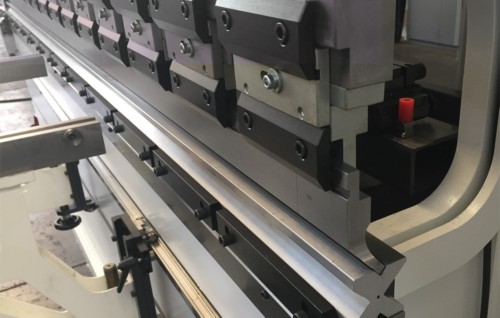PRESS BRAKE TOOLS FOR SHEET METAL BENDING – VARIATIONS, TYPOLOGY, DETAILS

Introduction
As the supplier of press brake tools we would like to make the detailed article about this product, details and specification from the beginning. Normally each customer needs only bending tools for the machine he uses but the general explanation is also important for understanding as well as the part of theory for press brake bending technology.
Press brake tools (or press brake tooling) are tools for press brake machine which should be installed in to perform the sheet metal bending. Press brake machine uses in very wide fields of industries and inside of every workshop to work with the sheet metal. Press brake tools are mainly the tools to get in touch with the metal itself and according to the force, stroke setup (positioning) and configuration to perform the controlled bending. Mainly all press brake tools should be considered as upper tool (punch), lower tool (die) and different auxiliary accessories such as different holders, adaptors, inserts, supports etc. The market of bending tooling is very wide because of the numerous amount of press brakes installed worldwide.
Meanwhile the one customer consumption is low because although the press brake tools are usual tooling and subject to wear, the life of use could be very long and last for years. It means it could be very typical that the customer uses bending tools for 3-5 years with normal care and following of recommendations (such as special bending with galvanic sheets, deburr before bending, precision force setup with appropriate limits, high quality of metal etc.). Usually the press brake tools are subject to buy if customer wants to produce other parts to get different configuration of tools, change the thickness of material to bend or replace the tooling after big wear or damaging because of high forces and other mistakes.
From the manufacturing side
Press brake tools are one of the special products from Italy. Means special because it is one of the strongest national products in Italy with distribution for all over the world. In Europe the concentration of Italian manufacturers of press brake tools is more than 70 percent for total product value. Moreover the network of resellers and dealers allows for manufacturers to conquest new markets so Italian tools are used on all continents including Australia, Asia, North and South America. The big competition comes from Asian manufacturers but usually mainly customers prefer European origin based on terms of quality and level of advertisement. This is also well-known picture that a lot of manufacturers of press brakes and other companies for industrial suppliers resell Italian press brake tools according to their own brand or trademark. As any tooling market press brake tools market is very competitive this means the possibility for the customer to get more than five offers for the same product before final decision to pay. Moreover, manufacturing companies are very skilled and qualified because any offer even for standard press brake tools could be connected with the necessity to provide and to recommend the way of bending. Usually press brake tools manufacturers know the technology of bending and how to implement different tools with much more great level of knowledge that the manufacturers of press brake machines. Because the mainly quality is the same high from main top press brake tools manufacturers the main competition usually based not in terms of quality but on the prices, technical knowledge, delivery time and after-sales support.
Typology based on systems
The main typology of press brake tools is the typology to divide according to the used system of press brake. This separation is the best and easiest one and used for all manufacturers to separate the parts of main product catalogs for specific systems. It also helps to the user to use only the part he need with the ignoring all other type of tools. System of press brake in terms of press brake tools means the configuration and geometry of clamping parts (tang and clamping holders) which are different for every system.

In general there are well known:
- Promecam or Amada Promecam or Euro or European - the most used clamping system for European and Asian press brakes. One of the easiest, oldest and usually has inside the widest selection of various configurations of tools to choose.
- American style – configuration of tang equal to use with North America press brakes. Meanwhile it is not only one geometry configuration tang but several different variants. In general “American style” is considered as standard straight tang without other projections but could be different.
- Trumpf-Wila - the system which is used on press brakes Trumpf (as the main user and developer) and today optionally could be provided at a lot of different trademarks of press brakes. This system is characterized with the buttons to click for possibility of frontal loading.
- Beyeler-Bystronic - the system which probably Swiss origin which is used on press brakes Bystronic. Today is less popular but still requested a lot according the numerous quantities of supplied machines of Bystronic trademark on the market. Also has several configurations from old to modern clamp systems.
- LVD – the system which is used on LVD press brakes with Belgium origin. Is not very massive and a lot of manufacturers do not make the tools for this system. Also has several configurations from old to modern clamp systems.
- More rear systems like HACO, COLLY, Colgar etc. together with modified Promecam system tooling like beveling edge tang etc.
- Heavy duty tools – different clamps and tangs mainly with bigger width than standard tools to be used with high tonnage forces for applications of hardest coining of big thickness bending. Have completely different geometries based on the manufacturer. Usually used with all tandem press brakes, big length press brakes (more than 6000 mm) or special configurations with big tonnages.
- Special bending tools which could use any tang geometry but unique made for special applications directly for customer’s request. Could be done for special profiling (like ribs, waves etc.), big radiuses out of standard program, special configurations (like Z-bending with minimum straight part, special flattening etc.) and other non-standard geometries. Normally in theory most of tools absent from standard manufacturing program of the manufacturer should be considered as specials.
Additionally it is important to say that all manufactures try to use their special configurations and now offered tools for different systems differ in geometry, angles and radiuses to be more similar to original tooling.
Type of bending tools
At the end we should say about type of tools which are used for purchase and bending. Thiese positions based on the press brake tools production and nearly similar for all main manufacturers worldwide.
Upper tool:
- Holders and intermediates to hold the punch
- Adapters to change system or elongation adapters
- Punches of straight type or with small internal groove (this is very theoretical separation based on preferences of specific manufacturer)
- Gooseneck or “swan-type” or “swan neck” – inclined punches with internal groove to have the possibility for material positioning inside
- Acute punches – US terminology usually means symmetrical straight and sharp angle (30-26 degrees)
- Radius punches solid or holders+inserts – tools to make radius bend with radius bigger than R10
- Flattening or hemming punches – tools to make the hemming bend (straight angle and after complete flattening)
Lower tool:
- Holders and intermediates to hold the die
- Adapters to change system or elongation adapters
- Standard V-dies with different angles including inserted types
- T-shape V-dies with different angles
- 2V dies with different angles (it means with the reposition the operator can change the opening on the same tool)
- 3V and 4V dies with different angles (it means with the reposition the operator can change the opening on the same tool)
- Multi-V dies with different angles with openings more than 4 (it means with the reposition the operator can change the opening on the same tool)
- Flattening or hemming dies
- Nylon, rubber, PU and other type dies or inserts with holders
In addition there could be various type of special tools made with the inserts or solid type